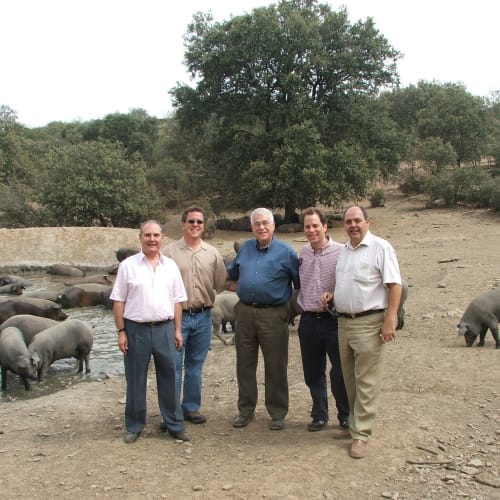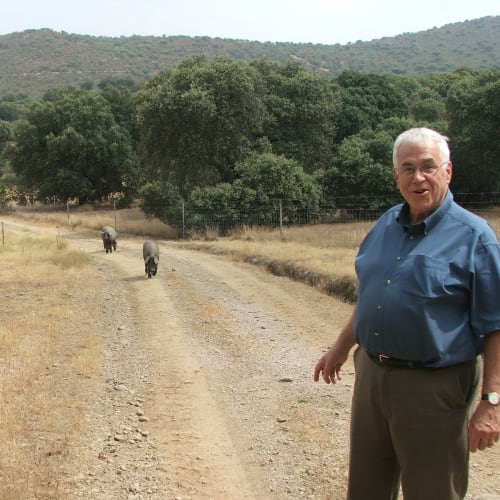My Friend, The Maestro of Jamón
Don Harris | September 2015




Our relationships with friends and colleagues in Spain are not only a personal pleasure, but part of how we try to run La Tienda. This year we asked our good friend Jorge Lancho to select the very finest hams for our Peregrino brand. Jorge is a maestro de jamón, a ham curing master, who has the experience to identify a great ham through appearance, aroma and texture. But we did not pull his name from an industry guide - he was a friend for over 10 years before we worked together. This is the story of how we came to collaborate after a decade of friendship.
Several years ago, I came across a little book named Pig Perfect, by Peter Kaminsky, concerning everything one might ever want to know about pigs, from the days of the pharaohs of Egypt to the type of pulled pork barbecue found in Wilson, North Carolina. Of course, prominent attention was paid to the ancient breed of Ibérico pigs of Spain and their idyllic life munching on acorns in the countryside. I was particularly interested in his description of a group of Spanish scientists at the University of Extremadura who had spent their careers learning all there was to know about the legendary Iberian animals and the exquisite Ibérico ham.
We at La Tienda wanted to know all about these pigs before we introduced the fabled Jamón Ibérico de Bellota, once international trade restrictions were lifted. With a sense of excitement, I told my sons Tim and Jonathan about what I had read, and proposed that the three of us make a trip to western Spain to see for ourselves. After all, these men were the ultimate experts in the raising of Ibérico pigs.

A quick contact was made, and the Spanish scientists were delighted to host us. We arrived in the environs of Cáceres, originally an ancient Roman outpost near the Portuguese border. We met our hosts at a local café close to a field where herds these pigs who were blissfully grazing. Dr. Antonio Gázquez, a veterinarian from the University of Extremadura, together with his friend Pedro Lancho, warmly welcomed us. After a sip of acorn liqueur, licor de Bellota, we piled into two Land Cruisers and headed for Pedro Lancho’s nearby finca or ranch.
Pedro was a highly respected civil engineer who inherited this acreage from his father. It is a beautiful piece of property located on the Dehesa – the remnant of the original oak forests of Europe. This is the ancient home of the Iberian pigs, cerdos Ibéricos. They are an ancient breed, whose ancestors have been strolling free in the Dehesa forest since the days of the cavemen.
After Pedro Lancho inherited this property, he made a radical career change: setting aside his successful career to devote his energy to raise Ibérico pigs, which in turn would produce superb Jamón Ibérico de Bellota.
He asked his son, Jorge, to join him in this new family enterprise. Jorge had just graduated from the University of Madrid with a Masters degree in Economics. The idea that he would be working with his dad in a family business was also appealing to him, as they began a quest to create the finest Jamón Ibérico de Bellota. Jorge knew his father as a very focused and intelligent man, and to some extent a perfectionist, so he had no doubt their mission would succeed.
In preparation for this venture, Pedro had become engrossed in Ibérico studies, learning from a faculty of veterinarians who knew more about this rare animal than anyone else in the world. He became close friends with his mentor, Dr. Antonio Gázquez, who enthusiastically encouraged Pedro and his son Jorge in this ambitious project. Father and son were inspired by the gifted and humble man who was first a scholar, then a gourmand, but most of all he was a gentleman - a humanitarian with a generous heart. I wrote about him several years ago in this essay.
This was the first time I had ever shared a sunny morning with a group of pigs, but I found them quite friendly animals, which freely interacted with us as we walked among them. Most of them chose to relax in the shade of the Holm oak trees that were close to a muddy waterhole.
In the autumn, these trees are laden with acorns (called bellotas in Spanish), which the pigs eat with abandon, sometimes gaining a kilo of weight per day! The jamones they produce are amazing - it literally melts in your mouth. More than half of their finely marbled fat is healthy mono-unsaturated, like olive oil, and melts at 70°F.
I could have lingered among the herd of pigs for a longer time. They are such fascinating, intelligent animals, and willing to relate to humans. One of them was a little fresh, and tried to nip one of us in the rump! Those of you who have lived in a rural area know exactly what I am talking about. (I understand wild boars are another story.)
After finishing our tour of the ranch, Pedro proudly showed us the modern curing facility that he had designed. While he was showing us many of the new features, my eyes were drawn to a very hard-working young man in a white coat, moving jamones. It was his son Jorge and it was there that I met him for the first time. Since then we have become fast friends.
By that time, it was mid-day and we joined our hosts, Pedro and Antonio, for a feast in a private dining room in the back of El Figon de Eustaquio in the medieval section of Cáceres. As many of you know, Spaniards traditionally eat expansive afternoon meals. (No quick sandwiches at the desk for them!) This one was a welcoming occasion and they provided us a gourmet feast, including Ajo Blanco soup, fresh local cheese, and most importantly, slices of the Lancho’s spectacular jamón. The hand cut slices glistened on the plate as the acorn flavored fat melted at room temperature!
Ruth and I returned to Cáceres a couple of years later and enjoyed a more intimate family meal with Jorge’s parents and his fiancée, Olga, who was a journalist with the national magazine La Razón. During their courtship, Jorge and Olga were torn between big city and small town life as they commuted back and forth to Madrid for almost seven years until 2005, when they chose to settle in Cáceres.
Over the years, the personal relationship with Jorge has grown. Ruth and I were particularly pleased when in 2010 Jorge and Olga drove several hours from Cáceres to the Parador at Carmona in order to introduce us to their first born, Guillermo, a robust and happy baby boy. Two years later they added to their family Diego, and then last year little Olga joined her two brothers!
Following our Carmona rendezvous, Jorge met us at one of our favorite towns: Ciudad Rodrigo situated on the frontier with Portugal. Together we explored Las Hurdes, a remote region of Spain deep in the Sierra de Gata Mountains, not far from the rustic town of La Alberca. Luis Bunuel made a famous movie in the 1930’s called Land Without Bread describing how civilization in this area had barely changed over the centuries.

The friendship between our families continued to grow last year when Jorge and Olga joined us for our Fiftieth Wedding Anniversary party in Carmona. Our friendship and the possibility of commercial opportunities became evident as the level of trust deepened between us.
All the while the artisan hams produced by the Lancho family company, called Encinar de Cabezón, were not allowed in the U.S. market. Certification by the USDA takes a significant investment, more than this small company could afford. Nevertheless, throughout our years of friendship we hoped to work together in some manner.
Finally, this year we found a way to work with our trusted friends. While we still can’t offer their excellent hams in the U.S., my son Tim recruited Jorge to use his experience as a Maestro de Jamón (ham master) to select the finest hams from another supplier to be used for our house Peregrino brand. We knew of no trusted expert in the industry who could take on the crucial task of differentiating the extraordinary jamones from the rest of those curing in the bodega.
For fifteen years Jorge has handled thousands of pieces of jamón, and knows the process from start to finish. Thanks to the friendship formed over many years between our two families, we have a premier selection of Jamón Ibérico de Bellota for our Peregrino brand.
The friendships we have built in Spain are rewarding and meaningful in their own right. But it is always satisfying when we can find a way to bring our trusted friends into the workings of La Tienda, which is our labor of love.
Tu amigo,
Don

